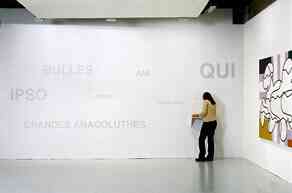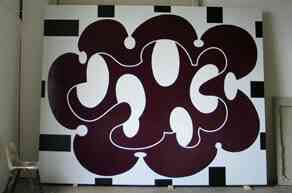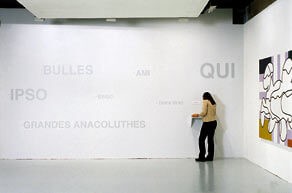Olivier Gourvil
Olivier Gourvil is an Astérides Resident in 2003 and 2004. The archives of Triangle-Astérides do not allow for the determination of the exact dates or the duration of this residency in 2003 and 2004.
Olivier Gourvil lives and works in Paris (FR)
Olivier Gourvil is without doubt the fortunate heir of style as a received idea. Thus, zigzags are only one of the motifs he deploys to trace a stylistic path that is no longer merely morphological, but also rhetorical. The spinning top, the bubble, and the balloon also inform the form-as-discourse of his paintings—not forgetting that the “bubble” also refers to a graphic device accompanying comic strip characters, and is, precisely, their “speech.” These comic bubbles delimit what counts as thought in the realm of visual fiction. They represent a supposed thought and a supposed speech that do not participate in the pictorial space—somehow added on, not truly formed, invisible as form. The bubbles thus become paratextual elements, transposed into a graphic language.
In his pictorial abstractions, Gourvil, an attentive observer of Pop Art and its implications, has realized the textual potential of this graphic idiom. His exhibitions bring together painted images that are the graphic equivalents of received ideas. Ipso features the profile of a sort of spinning top against a decorative background of colored bands, bordering on the cliché. In Bulles, schematic superimposed drawings evoke a sort of jabot or ruff surrounding a central black band “punctured” with holes. In Grandes Anacoluthes, a major painting, undulating lines create interference and produce a figure against a monochrome plaid background. If “anacoluthons” are syntactic discontinuities, then this painting surely delivers on its title!
The world of visual culture is a constant source of calligraphic gestures constituting codified graphic models, and Gourvil is clearly familiar with the full spectrum of these motifs. From the modern idiom and its countless variations scattered throughout contemporary art, Gourvil retains above all the semantic aspect of this visual culture. He evidently appreciates the post-pop grotesque of Carroll Dunham, who himself draws on the late imagery of Philip Guston, subjecting it to a “Pac-Man”-like stylization. In fact, the joke is twofold: by derivation, style becomes stylization. In this view, the notion of style is as grotesque as that of imitation. Through the stereotyped creations of Guston or Dunham, rage is unleashed through pictorial means designed to enchant us. The rigidified human subject is a familiar trope of the grotesque: we mock the biological creature turned mechanical.
Favoring this quality of rigidity, Gourvil renders it through quasi-abstract motifs—superimposed in such a way as to create visual discontinuities.
Text by Marjorie Welish, in Olivier Gourvil, exhibition catalogue, Le Quartier, Quimper, 2003.
Olivier Gourvil’s work is on display during the exhibition Trabendo, 2003.



